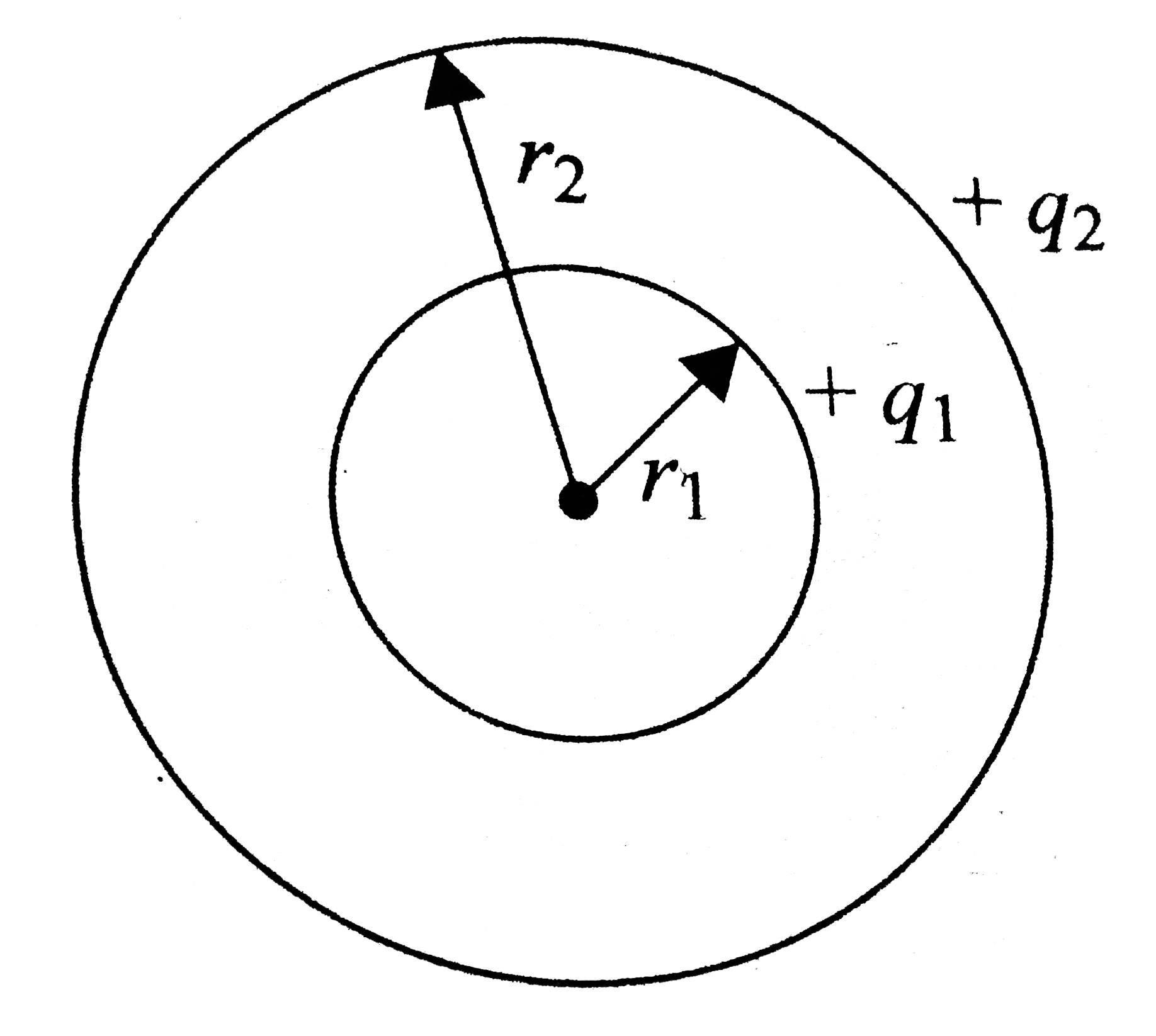You are given two concentric charged conducting spheres of radii such that having charges respectively and uniformly distributed over its surface. Calculate E and V at three points A, B , C whose distances from the centre are respectively as shown in figure.

At point A , the point A is outside both the spheres so for the purpose of calculation of E and V we have to consider both to be concentrated at the centre.
So, E
At point B : For electric field calculation note that the point B is inside the outer sphere so there will be no contribution of in the electric field at B. But for charges, the point B is outside so we have t assume to be at the centre and distance of B will be taken to be
So,
Now, for potential, remember that a single charge will never give zero contribution to potential at finite pionts.
So as well as will contribute to potential at B. Noe talk about the contribution of at point B you can see that the point B is inside the large sphere of so will offer its surface potential at all its inside points. but what about the potential contribution of at point B! for the point B is outside the sphere so, we'll assume as if is concentrated at the centre and the distance taken will be . so the contribution of in potential will be
Hence the total potential at B =
At point C :
For electric field note that to both . the point c is inside. So, the net contribution in the electric field will be zero, i.e E at C = zero. infact, at all the point inside the smaller sphere, the electric field will be zero,
whate about potential at C! For both the spheres the point C is inside so both will offer
their respective surface potential. since surface potential of is and that of is , hence the potential at C will be
In fact at all the points inside the inner sphere the potential will be constant and will be equal to the potential at C.
Topper's Solved these Questions
- ELECTROSTATIC POTENTIAL AND CAPACITANCE BOOK - AAKASH INSTITUTECHAPTER - ELECTROSTATIC POTENTIAL AND CAPACITANCE EXERCISE - TRY YOURSELF
110 Videos
- ELECTROSTATIC POTENTIAL AND CAPACITANCE BOOK - AAKASH INSTITUTECHAPTER - ELECTROSTATIC POTENTIAL AND CAPACITANCE EXERCISE - ASSIGNMENT (SECTION-A) Objective Type Questions (Only one answer)
47 Videos
- ELECTROMAGNETIC WAVESBOOK - AAKASH INSTITUTECHAPTER - ELECTROMAGNETIC WAVESEXERCISE - ASSIGNMENT SECTION - D Assertion-Reason Type Questions
25 Videos
- GRAVITATION BOOK - AAKASH INSTITUTECHAPTER - GRAVITATION EXERCISE - ASSIGNMENT SECTION - D (ASSERTION-REASON TYPE QUESTIONS)
16 Videos
Similar Questions
Two concentric, thin metallic spheres of radii R1 and R2 (R1>R2) bear charges Q1 and Q2 respectively. Then the potential at distance r between R1 and R_(2) will be
View SolutionThe insulated spheres of radii R1 and R2 having charges Q1 and Q2 respectively are connected to each other. There is
View Solution
Knowledge Check
Two conducting spheres of radii r1 and r2 having charges Q1 and Q2 respectively are connected to each other. There is
Ano change in the energy of the systemBan increase in the energy of the systemCalways a decrease in the energy of the systemDa decrease in the energy of the system unless Q1r2=Q2r1The insulated spheres of radii R1 and R2 having charges Q1 and Q2 respectively are connected to each other. There is
ANo change in the energy of the systemBAn increase in the energy of the systemCAlways a decrease in the energy of the systemDA decrease in the energy of the system unless
Q1R2=Q2R1The insulated spheres of radii R1 and R2 having charges Q1 and Q2 respectively are connected to each other. There is
ANo change in the electrical energy of the systemBAn increase in the electrical energy of the systemCAlways a decrease in the electrical energy of the systemDA decrease in electrical energy of the system until Q1R2=Q2R3
The insulated spheres of radii R1 and R2 having charges Q1 and Q2 respectively are connected to each other. There is
View SolutionTwo concentric spherical shells of radius R1 and R2(R2>R1) are having uniformly distributed charges Q1 and Q2 respectively. Find out total energy of the system.

View SolutionTwo concentric spherical shells of radius R1 and R2(R2>R1) are having uniformly distributed charges Q1 and Q2 respectively. Find out total energy of the system.

View SolutionTwo concentric, thin metallic spheres of radii R1andR2(R1>R2) charges Q1andQ2 respectively Then the potential at radius r between R1andR2 will be (k=1/4π∈)
View SolutionFigure shows two concentric conducting shells of radii r1 and r2 carrying uniformly distributed charges q1 and q2, respectively. Find an expression for the potential of each shell.
 .
.
View Solution
